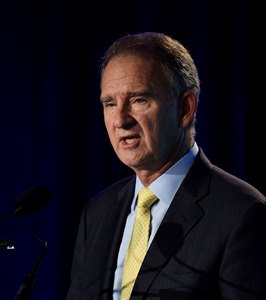NYRA Defends Financial Report at Meeting


The head of the New York Racing Association tangled with a state financial oversight board member Aug. 16 in a seemingly annual dispute over how the racing corporation reports on its financial performance.
"Stop," said Steve Newman, a member of the New York state Franchise Oversight Board, who interrupted a NYRA executive who was presenting an otherwise pro forma report on NYRA's second-quarter financial results.
Newman complained that NYRA was again offering a rosier-than-reality presentation by including revenue from the casino at Aqueduct Racetrack. NYRA gets a portion of the revenue from video lottery terminals operated by Genting Group.
NYRA reported a loss on racing operations of $4.3 million between January and the end of June; NYRA president and chief executive officer Chirs Kay told Newman that NYRA typically performs financially better in the second half of years thanks mostly to the revenunes from Saratoga Race Course meet.
Newman said NYRA was giving the board, created to oversee NYRA's finances, a false impression by allowing it to "claim that a $5 million loss is somehow a profit." Newman accused NYRA of "obfuscating" the facts to the public, and said NYRA should show proceeds from the Aqueduct casino separate from the racing side of its operations.
Instead, he said NYRA is "clearly sending a message to the public that's just not real."
"I respectfully disagree with you," Kay told Newman. Kay was in a meeting room at the state Capitol while Newman was being video-streamed from a New York City location.
"We are doing nothing to obfuscate any of the facts, and we answer all of your questions," Kay said.
NYRA was taken over by the state in 2012 in what was originally supposed to be a three-year reorganization period. Gov. Andrew Cuomo and lawmakers again this year could not agree on a privatization plan and extended the state's control until at least the end of 2017.
NYRA has been criticized for using VLT proceeds to mask financial issues on its racing side. In June, state comptroller Thomas DiNapoli, the state's chief fiscal watchdog, accused NYRA of running up deficits of $109 million over the past five years on racing operations by, among other things, excluding an array of expenses from its surplus calculations and using the Aqueduct casino revenues "to stay in the black." NYRA strongly dismissed the DiNapoli audit.
In a less combative period during Tuesday's oversight meeting, the panel approved a final environmental impact statement for future development at the Saratoga. NYRA first presented a plan for a series of changes around the historic racecourse in 2008; some of it has been met with community opposition over proposals some fear could inappropriately alter the facilities that are the summertime jewel of Thoroughbred racing in the United States and a major economic boost each year for the local region.
Robert Williams, head of the Franchise Oversight Board who is also executive director of the New York State Gaming Commission, said the plan—including changes to the front and backstretch areas, new buildings, and additional parking—amounts to the "quintessential long-term planning" document for Saratoga for the coming 10 years. He called it the first large-scale planning strategy for the track since the 1956 plan by The Jockey Club.
Williams, though, cautioned that individual capital projects identified in the plan will still have to face separate reviews, including by the Franchise Oversight Board and the New York state parks and historic preservation agency.
In its financial presentation, NYRA reported gross pari-mutuel revenue of $72.1 million during the second quarter of the year, down $647,000 from the same period a year earlier. When various payments, including purses, were taken out, NYRA was left with net wagering revenue of $32.9 million for the quarter, or $339,000 below a year earlier.
Its net revenue from racing operations stood at $44.7 million in the second quarter this year, down $643,000 from 2015.
NYRA raced 59 days during the period, down from 63 days during the second quarter of 2015; the state approved a NYRA plan to reduce two days this year as part of a "strategic reduction" to, in part, increase field size.
